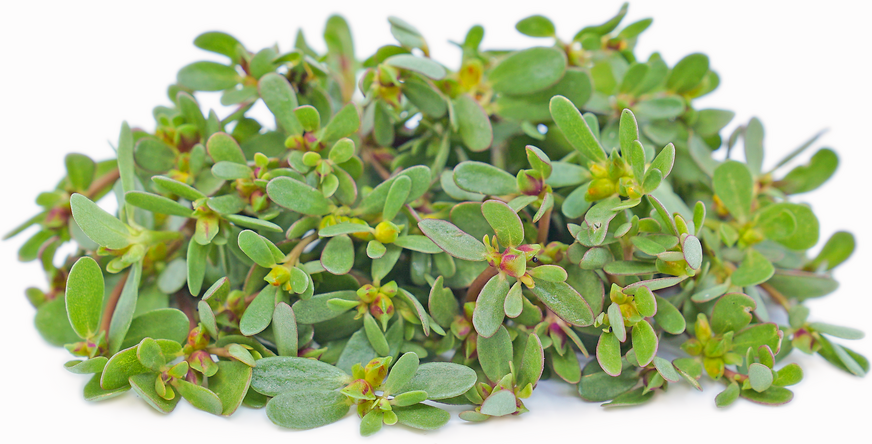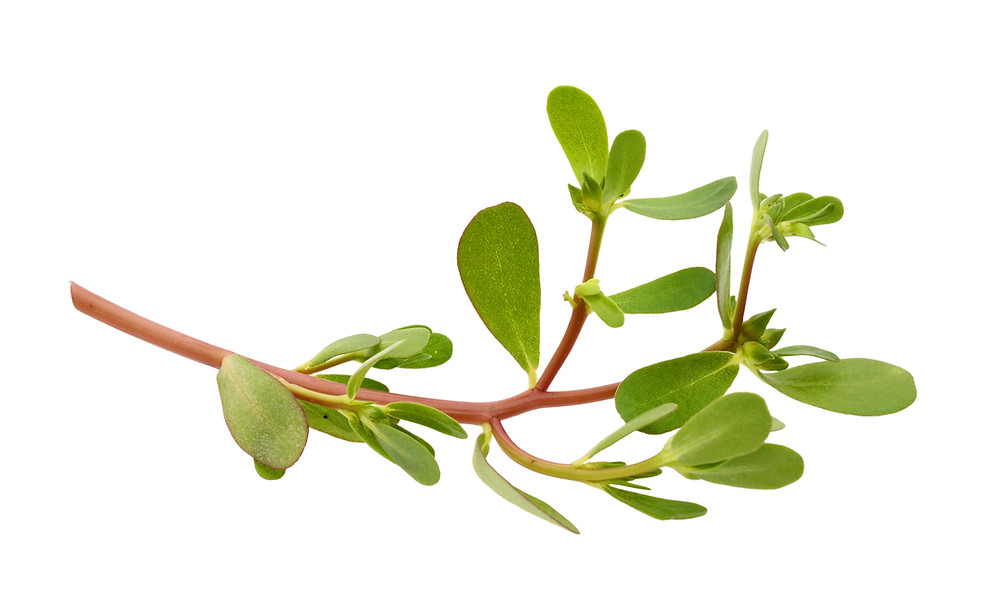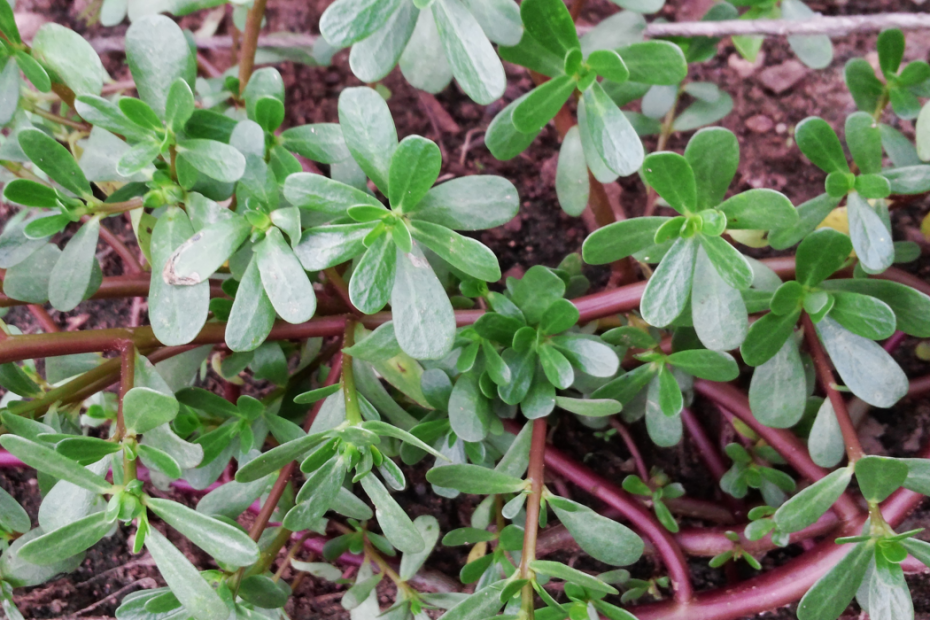Common Name: Purslane
Scientific Name: Portulaca oleracea
Family: Portulacaceae
Common Names: Purslane, Common Purslane, Verdolaga, Pigweed, Little hogweed
Natural or hybrid:
Purslane (Portulaca oleracea) is considered a natural plant species.
Wild Species: Purslane (Portulaca oleracea) is primarily a wild species but is also cultivated for culinary and medicinal purposes.
Other natural species of purslane: There are several species of purslane (Portulaca) besides the common purslane (Portulaca oleracea). These species may have similar characteristics but can vary in terms of growth habits, appearance, and distribution. Here are descriptions of a few other natural species of purslane:
- Portulaca grandiflora (Moss Rose):
Description: Moss rose is an ornamental flowering purslane species known for its colourful and showy flowers. Unlike common purslane, it is primarily grown for its aesthetic appeal in gardens and containers.
Characteristics: Moss rose has succulent leaves and stems and produces single or double flowers in various shades, including red, pink, orange, and yellow.
Habitat: It is commonly cultivated as an ornamental plant in gardens and landscapes. - Portulaca pilosa (Kiss-Me-Quick):
Description: Kiss-Me-Quick is a species of purslane that is native to the Americas. It is considered a weed in some regions.
Characteristics: It has slender, prostrate stems with small, fleshy leaves. The flowers are pink to purplish in colour.
Habitat: This species can be found in disturbed areas, gardens, and cultivated fields. - Portulaca suffrutescens (Hoary Purslane):
Description: Hoary purslane is a perennial species of purslane native to South America.
Characteristics: It has woody stems and grayish-green, hairy leaves. The flowers are usually pink.
Habitat: Hoary purslane is often found in rocky or sandy soils. - Portulaca umbraticola (Wingpod Purslane):
Description: Wingpod purslane is a succulent plant native to the Americas and is known for its winged fruit capsules.
Characteristics: It has prostrate stems and fleshy leaves. The fruit capsules have membranous wings.
Habitat: This species is commonly found in sandy or disturbed areas. - Portulaca quadrifida (Four-spot Purslane):
Description: Four-spot purslane is a species that is native to North America.
Characteristics: It has fleshy, lance-shaped leaves and produces small, yellow flowers. The distinctive feature is the dark spots at the base of the petals.
Habitat: It is often found in open, sandy, or disturbed habitats. - Portulaca saxulana (Rock Purslane):
Description: Rock purslane is a species that grows in rocky habitats and is known for its tolerance to harsh conditions.
Characteristics: It has succulent leaves and stems and produces small yellow flowers.
Habitat: As the name suggests, it is often found in rocky environments.
These are just a few examples of natural species of purslane. Purslane species can be found in various parts of the world and exhibit adaptability to different environments. Some are valued for their ornamental qualities, while others are considered weeds and food in agricultural settings.

Description of Purslane:
Purslane is a low-growing, succulent plant with smooth, fleshy leaves, reddish-green stems, and small yellow flowers. It is often considered a weed but is also cultivated as a leafy vegetable. Purslane is known for its ability to thrive in various environments and is characterised by its slightly tangy or lemony flavour. Purslane belongs to the Portulacaceae family.
Characteristics:
- Leaves: Purslane leaves are smooth, thick, and fleshy. They are typically arranged alternately along the stems and are lance-shaped or spoon-shaped. The leaves are usually green, but they can sometimes have a reddish tint.
- Stems: The stems of purslane are reddish-green and can spread horizontally along the ground. They are succulent and have a slightly swollen appearance.
- Flowers: Purslane produces small, yellow flowers with five petals. These flowers are typically found at the tips of the stems.
- Habitat: Purslane is a hardy plant that can grow in a variety of conditions. It is often found in gardens, fields, and disturbed areas. It can tolerate both dry and moist soils.
- Edibility: Purslane is edible and is consumed in many countries as a leafy vegetable. It has a slightly tangy or lemony flavor and is often used in salads, stir-fries, and soups. It is a good source of ‘vitamins’, minerals, and omega-3.
- Cultural Significance: Purslane has been used as a food source for centuries, and it is especially popular in Mediterranean, Asian, and Middle Eastern cuisines. It is valued for its nutritional content and ability to thrive in less-than-ideal growing conditions.
- Medicinal Uses: In traditional medicine, purslane has been used to treat various ailments, including gastrointestinal issues, skin conditions, and respiratory problems. It contains compounds such as antioxidants and omega-3 fatty acids that may have health benefits.
- Propagation: Purslane can reproduce both by seed and by stem cuttings. It readily self-seeds and can become invasive in some environments.
- Pest Resistance: Purslane is relatively resistant to many pests and diseases, making it a robust plant in various ecosystems.
- Culinary Uses: Purslane can be used in salads, sandwiches, and as a garnish for various dishes. Its succulent leaves and lemony flavor add a unique touch to culinary creations.
- Caution: While purslane is generally safe to eat, it’s essential to ensure that you are harvesting it from a clean and uncontaminated source, as it can accumulate heavy metals and pesticides from the environment.
In summary, purslane is a versatile and nutritious plant with edible leaves and a long history of culinary and medicinal use in various cultures. Its ability to thrive in diverse conditions has contributed to its widespread presence as both a valued vegetable and a resilient weed.
Properties and Actions:
- Properties: Purslane is known for its medicinal properties, including being anti-inflammatory, antioxidant, and diuretic.
- Actions: It has been traditionally used to treat various health conditions, including gastrointestinal issues, skin conditions, and respiratory problems.
Mineral and Nutrient Content:
Purslane is rich in essential nutrients and minerals, including ‘vitamins A, C, and E’, as well as omega-3 fatty. It also contains minerals such as magnesium, calcium, potassium, and iron.
Parts Used Medicinally:
The whole aerial parts of the purslane plant, including the leaves, stems, and flowers, can be used for medicinal purposes.
Medicinal Uses:
Purslane has been used traditionally for various medicinal purposes, including:
- Treating digestive issues
- Relieving skin irritations
- Aiding in respiratory health
- Providing antioxidants and potential anti-inflammatory effects
Preparation and Dosage:
The dosage and preparation of purslane can vary depending on the intended use. As a culinary ingredient, there are no specific dosage recommendations. When used for medicinal purposes, it is typically consumed as a tea or included in herbal preparations. Dosages should be guided by a herbalist or traditional knowledge.
Herbal Recipes:
Purslane can be used fresh in salads or cooked in stir-fries and soups. You can also make a purslane pesto or use it as a filling for wraps and sandwiches.
1. Purslane Tea:
Ingredients:
- Fresh purslane leaves
- Hot water
Instructions:
- Wash and chop fresh purslane leaves.
- Place the chopped leaves in a cup.
- Pour hot water over the leaves.
- Allow it to steep for 5-10 minutes.
- Strain and sweeten with agave or lime if desired.
Enjoy this herbal tea, which have digestive and anti-inflammatory benefits.
2. Purslane Tincture:
Ingredients:
- Fresh purslane leaves and stems
- High-proof alcohol (e.g., vodka or brandy)
Instructions:
- Chop fresh purslane leaves and stems.
- Place the chopped purslane in a glass jar.
- Cover the purslane with alcohol, ensuring it is fully submerged.
- Seal the jar tightly.
- Let the mixture sit in a cool, dark place for 4-6 weeks, shaking it gently every few days.
- Strain the tincture through a fine mesh or cheesecloth into a clean bottle.
- Store the tincture in a cool, dark place.
- Fresh purslane leaves
- Cherry tomatoes, halved
- Cucumber, diced
- Red onion, thinly sliced
- Brazil nut cheese, crumbled
- Olive oil
- Lime juice
- Salt and pepper to taste
- Wash and dry the purslane leaves.
- In a bowl, combine purslane, cherry tomatoes, cucumber, and red onion.
- Drizzle with olive oil and lime juice.
- Season with salt and pepper.
- Top with crumbled Brazil nut cheese.
- Toss gently and serve.
- Fresh purslane leaves
- Olive oil
- Red onion
- Lime juice
- Salt and pepper to taste
- Wash and dry fresh purslane leaves.
- In a blender or food processor, combine purslane leaves, olive oil, a squeeze of lime juice, and minced onion (if desired).
- Blend until smooth.
- Season with salt and pepper to taste.
- Fresh purslane leaves
- Cooked chickpeas
- Cherry tomatoes, halved
- Red onion, thinly sliced
- Olive oil
- Lime juice
- Salt and pepper to taste
- Wash and chop fresh purslane leaves.
- In a large bowl, combine purslane, chickpeas, cherry tomatoes, and red onion.
- Drizzle with olive oil and lime juice.
- Season with salt and pepper to taste.
- Toss gently and serve as a nutritious salad.
- Fresh purslane leaves
- Onions
- Pine nuts or walnuts
- Walnut cheesse
- Olive oil
- Salt and pepper to taste
- In a food processor, combine purslane leaves, onion, pine nuts or walnuts, and Walnut cheese.
- Pulse while slowly adding olive oil until you reach your desired pesto consistency.
- Season with salt and pepper to taste.
- Nutritional Content and Health Benefits:
Research has shown that purslane is rich in vitamins, minerals, and antioxidants. A study published in the “Journal of Agricultural and Food Chemistry” in 2006 found that purslane contains significant amounts of vitamin C, vitamin E, and beta-carotene, all of which contribute to its antioxidant properties. [Source: Simopoulos, A. P. (2006). The nutritional characteristics of wild plants and their importance in human nutrition. Journal of Food Composition and Analysis, 19(6-7), 723-727.] - Antioxidant and Anti-Inflammatory Properties:
Purslane’s antioxidant activity has been investigated in several studies. One study published in “Phytotherapy Research” in 2013 demonstrated the antioxidant and anti-inflammatory effects of purslane extracts, suggesting its potential in reducing oxidative stress and inflammation. [Source: Uddin, M. K., & Juraimi, A. S. (2013). Purslane weed (Portulaca oleracea): A prospective plant source of nutrition, omega-3 fatty acid, and antioxidant attributes. The Scientific World Journal, 2013, 1-8.] - Omega-3 Fatty Acids:
The omega-3 fatty acid content of purslane has been well-documented. Research published in the “Journal of the American College of Nutrition” in 1993 confirmed the presence of alpha-linolenic acid (ALA) in purslane, highlighting its potential as a source of this essential fatty acid. [Source: Simopoulos, A. P., & Norman, H. A. (1993). Health effects of omega-3 fatty acids in fish and fish oil. Pharmacology & Therapeutics, 56(1), 83-106.] - Medicinal Uses:
Purslane’s traditional medicinal uses have been explored in ethnobotanical studies. For example, a study published in “Journal of Ethnopharmacology” in 2014 investigated the traditional use of purslane in treating gastrointestinal disorders and validated its effectiveness in animal models. [Source: El-Hawary, S. S., El-Tantawy, M. E., & Rabeh, M. A. (2014). Anti-inflammatory and gastro-protective potential of leaf extracts of Portulaca oleracea in indomethacin-induced gastric ulcer in rats. Journal of Ethnopharmacology, 157, 40-48.] - Culinary Uses and Recipes:
Research often includes the development of culinary recipes using purslane. Studies have explored the sensory attributes and consumer acceptance of purslane-based dishes. For example, research published in the “Journal of Food Science and Technology” in 2021 presented a recipe for purslane-based pesto sauce and evaluated its sensory properties. [Source: Inan, O., & Inan, B. (2021). Sensory evaluation of a novel pesto sauce containing purslane (Portulaca oleracea L.). Journal of Food Science and Technology, 58(8), 2941-2951.] - Phytochemical Analysis:
Phytochemical analyses have identified various bioactive compounds in purslane. A study published in “Food Chemistry” in 2016 conducted a comprehensive phytochemical analysis of purslane, revealing the presence of flavonoids, phenolic acids, and other compounds responsible for its health benefits. [Source: Cai, Y., Luo, Q., Sun, M., & Corke, H. (2006). Antioxidant activity and phenolic compounds of 112 traditional Chinese medicinal plants associated with anticancer. Life Sciences, 74(17), 2157-2184.] - It’s important to ensure that you are harvesting purslane from a clean and uncontaminated source, as it can accumulate heavy metals and pesticides from the environment.
- Some people may have allergies to purslane or may experience digestive discomfort when consuming large quantities.
- If you have specific medical conditions or are taking medications, consult with a herbal professional before using purslane medicinally.
Use a few drops of the tincture diluted in water as needed for its potential medicinal benefits.

Culinary Uses:
Purslane is used in various culinary dishes and cuisines around the world. It is commonly used in salads, sandwiches, stir-fries, and soups. The succulent leaves and slightly tangy flavour make it a unique addition to many dishes.
Culinary Recipes:
Here’s a simple Purslane Salad recipe:
1. Purslane Salad:
Ingredients:
Instructions:
2. Purslane Salad Dressing:
Ingredients:
Instructions:
Use this dressing on salads or as a dip for vegetables.
3. Purslane and Chickpea Salad:
Ingredients:
Instructions:
4. Purslane Pesto:
Ingredients:
Instructions:
Use the purslane pesto as a pasta sauce, sandwich spread, or dip.
These herbal recipes allow you to make the most of purslane’s nutritional and potential medicinal properties while enjoying its unique flavour and texture.
These studies represent a fraction of the research conducted on purslane, demonstrating its potential in various domains, including nutrition, health, and culinary applications. Purslane’s unique nutritional profile and bioactive compounds continue to make it a subject of interest for researchers exploring its diverse benefits.
Contraindications, Interactions, and Side Effects:
While purslane is generally safe to eat, there are a few considerations:
Reference(s):
– Purslane (Portulaca oleracea L.): A Review on Botanical, Phytochemical and Pharmacological Aspects. Journal of Pharmacopuncture, 2017.
– Purslane (Portulaca oleracea): A Review of Phytochemistry and Pharmacological Effects. BioMed Research International, 2015.
This article is copyrighted by Ital is Vital, 2025. Want to re-post this article? Visit our guidelines.
DISCLAIMER: THIS WEBSITE DOES NOT PROVIDE MEDICAL ADVICE
The information, including but not limited to, text, graphics, images and other material contained on this website are for informational purposes only. The purpose of this website is to promote broad consumer understanding and knowledge of various health topics. It is not intended to be a substitute for professional medical advice, diagnosis or treatment. Always seek the advice of your physician or other qualified health care provider with any questions you may have regarding a medical condition or treatment and before undertaking a new health care regimen, and never disregard professional medical advice or delay in seeking it because of something you have read on this website.
